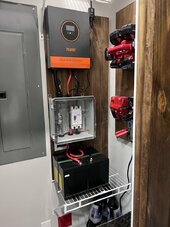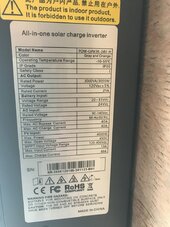@Chri5co63 I am going to set my CHINS to the parameters in post #23 because they look more realistic than the defaults and I will let you know what happens.
You are using an out of date browser. It may not display this or other websites correctly.
You should upgrade or use an alternative browser.
You should upgrade or use an alternative browser.
Need help with PowMr 3000W 24V Solar Inverter Charger parameters settings
- Thread starter Chri5co63
- Start date
Chri5co63
New Member
This is our setup with connections as shown (less the separate inverter and charge controller as we’ve replaced those with the on MrPow inverter charger…If all 12 panels are connected in series then amps =9.02a, voltage = 21.6v x 12=264v w=2381
But if I have interpreted what you have said above
If they are connected 6 strings of 2 in parallel=
2 in series =9.02a,voltage =2 x 21.6v=43.2v
then 6 in parallel =9.02 x 6= 54a, voltage =43.2v w=2332
In the listing above it suggests max charge amp from inverter to battery =02c =40a... 20% of a 200ah battery. Your peak solar pv output is 54a. at 43.2vdc available to the inverter
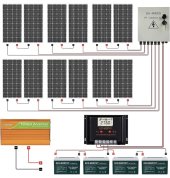
Last edited:
ian.blackshaw
New Member
- Joined
- Sep 7, 2022
- Messages
- 17
looks like 6 parallel groups of 2 series panels.
mib
New Member
It seems to me that we are talking about AIO SRNE, this is a manufacturer, powmr brand
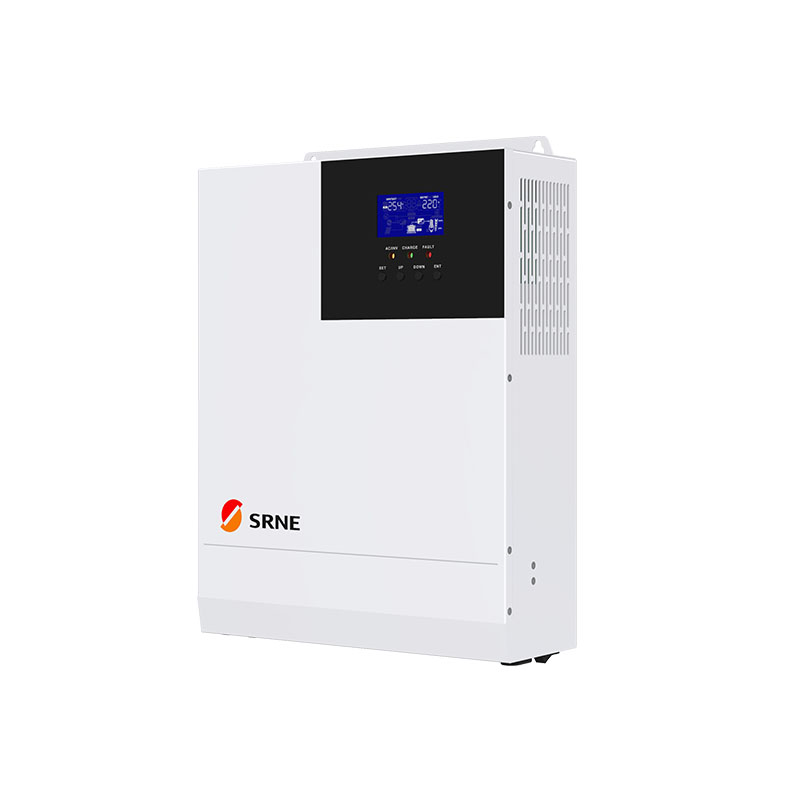
my version is 220 volt

it says here, the maximum current from the panels is 40 amperes
2s6p you get 54 amps which is more than 40 amps
maybe 3s4p is better for you
also note there is a maximum pv power parameter of 1600 watts, which is less than 2332 watts
Are your solar panels already connected?
i also want to go over 1600 watts, my panels are 595 watts in a 2s2p circuit i fit into 80 volts and 36 amps, 2380 watts
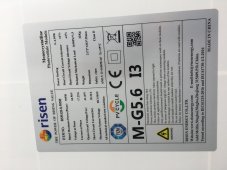
but i have feelings about it

3KW SRNE Off-Grid Solar Inverter 24V HF2430U60-100 - SRNE Solar
Max.Voc:100V;Rated input voltage:110/120V HF Series is new hybrid solar charge inverter, which integrates PV charge &Grid(Generator) charge with AC sine wave output. Adopting DPS control algorithm, getting higher response speed, higher reliability and higher industrial standard.
www.srnesolar.com
my version is 220 volt

it says here, the maximum current from the panels is 40 amperes
2s6p you get 54 amps which is more than 40 amps
maybe 3s4p is better for you
also note there is a maximum pv power parameter of 1600 watts, which is less than 2332 watts
Are your solar panels already connected?
i also want to go over 1600 watts, my panels are 595 watts in a 2s2p circuit i fit into 80 volts and 36 amps, 2380 watts

but i have feelings about it
Chri5co63
New Member
The following is a link for the manual for our PowMister Solar Charger.It seems to me that we are talking about AIO SRNE, this is a manufacturer, powmr brand

3KW SRNE Off-Grid Solar Inverter 24V HF2430U60-100 - SRNE Solar
Max.Voc:100V;Rated input voltage:110/120V HF Series is new hybrid solar charge inverter, which integrates PV charge &Grid(Generator) charge with AC sine wave output. Adopting DPS control algorithm, getting higher response speed, higher reliability and higher industrial standard.www.srnesolar.com
my version is 220 volt
View attachment 135182
it says here, the maximum current from the panels is 40 amperes
2s6p you get 54 amps which is more than 40 amps
maybe 3s4p is better for you
also note there is a maximum pv power parameter of 1600 watts, which is less than 2332 watts
Are your solar panels already connected?
i also want to go over 1600 watts, my panels are 595 watts in a 2s2p circuit i fit into 80 volts and 36 amps, 2380 watts
View attachment 135187
but i have feelings about it
One can find on pp. 31-32, the Technical Specifications. The listed Maximum Input Current is 60A and the PV Charging Current Range is 0-60A.
The following is a picture of the label on one of our solar panels...
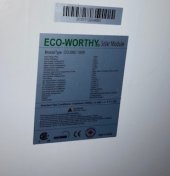
ian.blackshaw
New Member
- Joined
- Sep 7, 2022
- Messages
- 17

Mark Durrenberger’s Blog — writing about homes and energy.
What Does Solar “Inverter Clipping” Mean?
November 2, 2017The short answer is that “inverter clipping” means your solar inverter is limiting slightly the amount of electricity going from your solar energy system into your household for use, because it reached its maximum capacity.
Here’s a longer explanation.
For background you should know that, like solar panel ratings, inverter ratings are approximate. Many inverters can convert more DC power (from your panels) to AC (for use in your home or business) than their model numbers imply. For example, the maximum power output of the SolarEdge SE7600A is actually 8,350 watts, according to the manufacturer. So the inverter has no problem handling up to 8,350 watts of capacity at a time.
If the panels are operating at a capacity that exceeds the inverter’s capacity, “clipping” occurs. The inverter trims the output to the maximum it can handle and you lose a little production. This graph shows a customer’s production with clipping at the top of the curve.
Reference above "clipping" If the panel output is greater than the inverter spec......
Chri5co63
New Member
?@Chri5co63 I am going to set my CHINS to the parameters in post #23 because they look more realistic than the defaults and I will let you know what happens.
mib
New Member
I have exactly the same instruction, but on the side panel of the AIO there are these 1600 watts and 40 ampsThe following is a link for the manual for our PowMister Solar Charger.
One can find on pp. 31-32, the Technical Specifications. The listed Maximum Input Current is 60A and the PV Charging Current Range is 0-60A
can you take a photo sticker of your AIO's specs?
do you already have everything working? and you want to change only the battery or the system is just planned?
Chri5co63
New Member
Aha. Nice article! In another...
Mark Durrenberger’s Blog — writing about homes and energy.
What Does Solar “Inverter Clipping” Mean?
November 2, 2017
The short answer is that “inverter clipping” means your solar inverter is limiting slightly the amount of electricity going from your solar energy system into your household for use, because it reached its maximum capacity.
Here’s a longer explanation.
For background you should know that, like solar panel ratings, inverter ratings are approximate. Many inverters can convert more DC power (from your panels) to AC (for use in your home or business) than their model numbers imply. For example, the maximum power output of the SolarEdge SE7600A is actually 8,350 watts, according to the manufacturer. So the inverter has no problem handling up to 8,350 watts of capacity at a time.
If the panels are operating at a capacity that exceeds the inverter’s capacity, “clipping” occurs. The inverter trims the output to the maximum it can handle and you lose a little production. This graph shows a customer’s production with clipping at the top of the curve.
Reference above "clipping" If the panel output is greater than the inverter spec......
"Inverters are most efficient when running at or near full capacity. Going up an inverter size, for example installing an SE-10,000 inverter with a 7,500-watt system, would make the system less efficient. The lost production in that scenario would be more than the little bit of production lost from occasional clipping.
Makes me wonder if our inverter is too large compared to the PV Input wattage.
Put another way, the choice is lower efficiency 365 days a year, or very high efficiency year-round with occasional clipping. You get considerably more solar production in the second scenario." - (Mark Durrenberger’s Blog — writing about homes and energy.)
Yes, the solar panels have been connected since last summer. We connected them according to the Eco-Worthy Kit setup instructions.It seems to me that we are talking about AIO SRNE, this is a manufacturer, powmr brand

3KW SRNE Off-Grid Solar Inverter 24V HF2430U60-100 - SRNE Solar
Max.Voc:100V;Rated input voltage:110/120V HF Series is new hybrid solar charge inverter, which integrates PV charge &Grid(Generator) charge with AC sine wave output. Adopting DPS control algorithm, getting higher response speed, higher reliability and higher industrial standard.www.srnesolar.com
my version is 220 volt
View attachment 135182
it says here, the maximum current from the panels is 40 amperes
2s6p you get 54 amps which is more than 40 amps
maybe 3s4p is better for you
also note there is a maximum pv power parameter of 1600 watts, which is less than 2332 watts
Are your solar panels already connected?
i also want to go over 1600 watts, my panels are 595 watts in a 2s2p circuit i fit into 80 volts and 36 amps, 2380 watts
View attachment 135187
but i have feelings about it
ian.blackshaw
New Member
- Joined
- Sep 7, 2022
- Messages
- 17
I don't think it overly matters if the panels give out a little more than the inverter is rated at ,,,, possibly up to 20% but it is important you are aware of it. Especially If like in the Uk there is little chance of achieving maximum solar output.
mib
New Member
that's exactly my goalor very high efficiency year-round with occasional clipping
1600/2400 turns out 50% but is fully invested in the parameters for both current and voltageI don't think it overly matters if the panels give out a little more than the inverter is rated at ,,,, possibly up to 20% but it is important you are aware of it. Especially If like in the Uk there is little chance of achieving maximum solar output.
but you calmed me down a bit
ian.blackshaw
New Member
- Joined
- Sep 7, 2022
- Messages
- 17
never was good at maths?
mib
New Member
i plan to do the following settings for lifepo4 140 ah 24 voltss battery
04 26 (3,25) v
05 26,4 (3,3) v
07 40 amper
08 USE
09 Boost charge - 27,6 (3,45) v
10 Boost charge time - 120 min
11 Floating charge - 27,6 (3,45) v
12 Over discharge voltage - 24 (3) v
13 Over discharge time - 30 sec
14 Under voltage alarm - 24,8 (3,1) v
15 Discharge limit - 24,4 (3,05) v
17 Equalization voltage - 27,6(3,45) v
28 Max AC charger current - 10 amper
35 Undervoltage recovery - 25,6 (3,2) v
36 Max PV charger current - 40 amper
37 fully charged recovery - 26,8 (3,35) v
my goal is to use the battery as little as possible, during normal times, to save it during city grid outages
04 26 (3,25) v
05 26,4 (3,3) v
07 40 amper
08 USE
09 Boost charge - 27,6 (3,45) v
10 Boost charge time - 120 min
11 Floating charge - 27,6 (3,45) v
12 Over discharge voltage - 24 (3) v
13 Over discharge time - 30 sec
14 Under voltage alarm - 24,8 (3,1) v
15 Discharge limit - 24,4 (3,05) v
17 Equalization voltage - 27,6(3,45) v
28 Max AC charger current - 10 amper
35 Undervoltage recovery - 25,6 (3,2) v
36 Max PV charger current - 40 amper
37 fully charged recovery - 26,8 (3,35) v
my goal is to use the battery as little as possible, during normal times, to save it during city grid outages
Chri5co63
New Member
The system has been up and running (charging 4 12v Lead Acid Gel batteries connected in 2S/2P for 24v) since las summer. At this time, we are only replacing the batteries with 4 Chins LiFePo4 12v 200AH batteries connected in 2S/2P for 24v.I have exactly the same instruction, but on the side panel of the AIO there are these 1600 watts and 40 amps
can you take a photo sticker of your AIO's specs?
do you already have everything working? and you want to change only the battery or the system is just planned?
Currently, I am not at the cavin where the solar array is, so I cannot supply you with a photo of the side sticker. I believe you can find the same information on pages 31-32 in the manual in the following link:
(i.e. In the above manual, on page 32, under the Solar (PV) Charging section, it reads Max Input Power as 1400w and Maximum Input Current as 60A)
However, When I look up the inverter on Amazon (where it was purchased), I find the following photo (not of the sticker, but "brochure"):

Attachments
ian.blackshaw
New Member
- Joined
- Sep 7, 2022
- Messages
- 17
what are parameters 04 and 05i plan to do the following settings for lifepo4 140 ah 24 voltss battery
04 26 (3,25) v
05 26,4 (3,3) v
07 40 amper
08 USE
09 Boost charge - 27,6 (3,45) v
10 Boost charge time - 120 min
11 Floating charge - 27,6 (3,45) v
12 Over discharge voltage - 24 (3) v
13 Over discharge time - 30 sec
14 Under voltage alarm - 24,8 (3,1) v
15 Discharge limit - 24,4 (3,05) v
17 Equalization voltage - 27,6(3,45) v
28 Max AC charger current - 10 amper
35 Undervoltage recovery - 25,6 (3,2) v
36 Max PV charger current - 40 amper
37 fully charged recovery - 26,8 (3,35) v
my goal is to use the battery as little as possible, during normal times, to save it during city grid outages
Chri5co63
New Member
I do like all the responses to the posts on this thread, not only is it helpful to me and my situation, but probably somewhat to each of you to some degree. The more I read and study, the more intrigued I become and the more I realize that their is no limit to all the possibilities in solar energy production.
...according to the manual, that is.
what are parameters 04 and 05
04 | Battery Power to Utility Setpoint | 23.0V (Default) | Setting voltage point back to utility source when selecting “SBU” in Program {01}. When the voltage of the battery is lower than this setting, the output switches from inverting to the utility (generator). The setting range is from 22c – 26-v in 0.2v increments. |
05 | Utility to Battery Power Setpoint | {05} 28.0v (Default) | Setting voltage point back to battery mode when selecting “SBU” in Program {01}. When the battery voltage is higher than the setting value, the output is switched from the utility to the battery mode. The setting range is 24V – 30V, in 0.2V increments * Cannot be higher than setting in {14} |
The CHINS Inverter started doing weird things so I set it back to where it was. It appears that my batteries, TCBWorth, don't like those settings. I have tried to get the parameter info from them but got no response.
mib
New Member
@Chri5co63 I am very pleased with your experience, I hope everything will be just as successful with connecting solar panels
ian.blackshaw
New Member
- Joined
- Sep 7, 2022
- Messages
- 17
My inverter shows battery 24.9v now. (15% capacity) but my battery has still got 46% capacity ... my BMS shows 3,15v per cell (x8)=25.2v (100ah 24v )
Because my inverter is on battery load the voltage drops dependant on variation in the load.
So the inverter is showing the battery voltage under load and not battery capacity left in AH's
Therefore I think (26) 3.25v on the inverter is high probably still got 60ah left in the battery
Because my inverter is on battery load the voltage drops dependant on variation in the load.
So the inverter is showing the battery voltage under load and not battery capacity left in AH's
Therefore I think (26) 3.25v on the inverter is high probably still got 60ah left in the battery
Last edited:
Chri5co63
New Member
Like I said previously, I am impressed and grateful with the correspondence from Chins. Not so much with PowMr, as the only response I received was to set the Battery Type as "User". Big Deal ?The CHINS Inverter started doing weird things so I set it back to where it was. It appears that my batteries, TCBWorth, don't like those settings. I have tried to get the parameter info from them but got no response.
Dr._Prof_ECECS
New Member
@LSC I have the same situation in my new, first experimental system ("P28 is coming from the grid and it is only tied to a 20A breaker right now."). So, I set the max current to 20A thinking it is the limit on the current taken from AC. But I found it was taking for ever to charge the battery (I shut it off since my solar panels, used ones from Santander, had only OC of 32.4V and op. vol. of 28.4 and was not charging as MPPT vol range was 30 to 100. But then when I put two in series, still it did not charge and vol total was only 32.4V. My panels are on the ground with shadows from building etc.). So, I am wondering if this number (that you and I set as 20A), refers to the battery charging current OR the current drawn from the AC. Right now, I have just two 12.6 vol LiFeP4 batteries in series, each, 100 Ah (Eco-Worthy batteries). -- So, at 20A battery charging current, two batteries should have been charged in 10 hours. And at 20A grid current, just two hours (approximate - You have RMS value for the AC etc.) which did not happen.
So, 20A is AC current or DC battery charging current? TIA
So, 20A is AC current or DC battery charging current? TIA
Thank you guys for this post. I’m new and following as I have just set up a 3000 watt Powmr system. No pv yet but 2 100ah batts. I’m just trying to follow one of y’all’s setups and get my feet wet into all this new technology. Thanks will continue to follow and hope to get the right setting for me.
Attachments
SeanEnjoying
New Member
- Joined
- Apr 2, 2021
- Messages
- 6
I have recently purchase a similar unit from them. Can take much more input for panels.
Just read thru the thread, great info. When I went thru my manual, some setting did not match the inverter settings. I adjusted some based on this thread, will be looking at others over the next few days. Total newbie here.
4@330w 36v panels. In series
POW-LVM3K-24-H
4 @ 12v 100 ah 2S2P
This inverter needs a minimum of 150v or 120v by manual.
Now I need some sun, so I can see more smartness logging!
Just read thru the thread, great info. When I went thru my manual, some setting did not match the inverter settings. I adjusted some based on this thread, will be looking at others over the next few days. Total newbie here.
4@330w 36v panels. In series
POW-LVM3K-24-H
4 @ 12v 100 ah 2S2P
This inverter needs a minimum of 150v or 120v by manual.
Now I need some sun, so I can see more smartness logging!
Attachments
Similar threads
- Replies
- 44
- Views
- 2K
- Replies
- 2
- Views
- 861
- Replies
- 4
- Views
- 588
- Replies
- 8
- Views
- 1K




